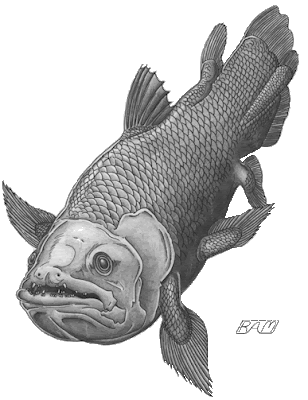| Erik Jarvik (1907-1998) Image Miguasha National Park |
Anders Erik Vilhelm Jarvik (30 November 1907 – January 11, 1998) was a Swedish palaeozoologist who worked extensively on the sarcopterygian (or lobe-finned) fish Eusthenopteron.Erik Jarvik did his lifework in the Swedish Museum of Natural History in Stockholm starting in 1937 and becoming the professor and head of department in 1960. Jarvik has written extensively on sarcopterygian fossils and published two books on the subject
In a career that spanned some 60 years, Jarvik produced some of the most detailed anatomical work on this fish, making it arguably the best known fossil vertebrate."
wikipedia
- Théories de l'évolution des vertébrés reconsidérées à la lumière des récentes découvertes sur les vertébrés inférieurs. Masson, Paris. 1960.
- Basic Structure and Evolution of Vertebrates, 2 Vols. Academic Press, London. 1980
3D-modelling before computers
| Erik Jarvik’s wax model showing the cavities and canals inside the neurocranium of Eusthenopteron foordi Image Miguasha National Park |
Erik Jarvik conducted detailed anatomical studies of the cranium of Eusthenopteron foordi using a serial-section technique introduced by William Johnson Sollas and applied to fossil fishes by Erik Stensiö.
A fossil of limited external quality was sectioned by grinding off a thin section, photographing the grind-off end and repeat the process until the whole fossil was worked through. The internal structures would then show up on long series of photographs.
Working in the day before computer simulations, models was made by projecting reversal film on a board, and cut thin wax plates to match. The sticky wax plates could then be assembled to a 3 dimensional scaled up model of the skull, complete with internal structures such as nerve channels and other internal hollows rarely seen in fossils.
Further section to the cranium could easily be made by cutting the wax model at the desired angle. Due to the sticky nature of the wax used, a sectioned skull was put back together by simply pressing the two sections back together. This technique was also applied to the cranium of the porolepiform Glyptolepis groenlandica.
wikipedia
Important but passée
On the basis of his detailed studies of the heads of Eusthenopteron Jarvik proposed a theory on the evolution of tetrapods in which amphibious animals were classed into two groups, one related to salamanders and the other to frogs. According to Jarvik amphibian life evolved twice in prehistoric planet Earth.
Jarvik also studied the anatomy and relationships of lungfish which he held to be relatively primitive gnathostomes, possibly related to holocephalans, and of acanthodians, which he considered to be elasmobranchs rather than osteichthyans.
He made contributions to a number of classical problems in comparative anatomy, including
- the origin of the vertebrates
- the origin of the pectoral and pelvic girdles
- the origin of paired fins
- the homologies of the frontal and parietal bones in fishes and tetrapods
Finally, Jarvik investigated the anatomy of Ichthyostega, resulting in a monograph with an extensive photographic documentation of the material collected in 1929-1955.
Jarvik, E. (1996). The Devonian tetrapod Ichthyostega. Fossils and Strata, 40, 1-213.
Some of Jarvik’s views did not accord with general opinion in vertebrate palaeontology However, his anatomical studies of Eusthenopteron foordi laid the foundations for modern studies of the transition from fishes to tetrapods.
Jarvik was a member of the Royal Swedish Academy of Sciences and French Academy of Sciences and Knight of the Order of Vasa. The lungfish Jarvikia and the osteolepiform Jarvikina are named after him.
wikipedia



























.png)
















